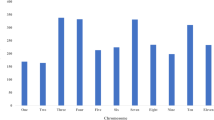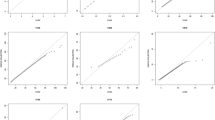Summary
Management of a genetic resources collection is more effective if a curator can accurately identify genotypes and accessions as well as assess intraspecific genetic relationships and the genetic structure of species. Consequently, a study was conducted to determine whether data from starch gel electrophoresis of a specific set of isozymes from plants of Brassica oleracea (cole crops) would be useful in answering four questions the answers to which are essential for effective curatorial activities: Can individual plants be identified? Can specific accessions be identified? What are the genetic relationships among botanical varieties within B. oleracea? What is the genetic structure of the species B. oleracea? Six loci from 4 enzyme systems (LAP, PGD, PGI, and PGM) were analyzed. Individuals and accessions could not usefully be identified using these isozymes, but genetic relationships within and genetic structure of the species were easily determined, resulting in specific recommendations for improving collection management. As expected, highly selected commercial lines exhibited less diversity than average, and so may be of limited value when trying to maximize diversity with a minimum number of accessions. In contrast, landraces and weakly selected lines are more diverse than average, and thus are useful in maximizing per accession diversity. Not only was 93% of the genetic variability in B. oleracea found among accessions and a mere 7% among varieties, but also a cluster analysis showed that accessions of a single botanical variety are often more similar to those of a different variety than to each other. These results suggest that in order to create a genetic resources collection of B. oleracea that faithfully represents the diversity in the species, a curator should assemble a broad array of accessions originating from diverse agroecological niches, having different levels of improvement, and representing all botanical varieties.
Similar content being viewed by others
Abbreviations
- LAP:
-
Leucine amino peptidase
- PGD:
-
6-Phosphogluconate dehydrogenase
- PGI:
-
Phosphoglucoisomerase
- PGM:
-
Phosphoglucomutase
- RAPD:
-
Random amplified polymorphic DNA
- RFLP:
-
Restriction fragment length polymorphism
- UPGMA:
-
Unweighted pair-group method using arithmetic averages
References
Arus, P. & T. J. Orton, 1983. Inheritance and linkage relationships of isozyme loci in Brassica oleracea. J. Hered. 74: 405–412.
Arus, P. & C. R. Shields, 1982. Cole crops (Brassica oleracea L.). In: S. D. Tanksley & T. J. Orton, (Eds) Isozymes in plant genetics and breeding, part B. Elsevier, Amsterdam. p. 339–350.
Brown, A. H. D., 1978. Isozymes, plant population genetic structure and genetic conservation. Theor. Appl. Genet. 52: 145–157.
Brown, A. H. D., 1989a. The case for core collections. In: A. H. D. Brown, O. H. Frankel, D. R. Marshall & J. T. Williams, (Eds) The use of plant genetic resources. Cambridge University Press, Cambridge. p. 136–156.
Brown, A. H. D., 1989b. Core collections: A practical approach to genetic resources management. Genome 31: 818–824.
Guo, Z. H., M. R. Nolan, B. E. Recchio-Demmin, J. R. McFerson & S. Kresovich, 1991. Optimization of starch gel electrophoresic techniques for use in genetic conservation of Brassica oleracea L. Cruciferae Newsletter, 14/15: 72–73.
Hamrick, J. L. & M. J. W. Godt, 1990. Allozyme diversity in plant species. In: A. H. D. Brown, M. T. Clegg, A. L. Kahler &. B. S. Weir, (Eds) Plant population genetics, breeding, and genetic resources. Sinauer Associates, Inc., Sunderland, Massachusetts. p.43–63.
Hu, J. & C. F. Quiros, 1991. Identification of broccoli and cauliflower cultivars with RAPD markers. Plant Cell Reports 10: 505–511.
Kresovich, S. & J. R. McFerson, 1992. Assessment and management of plant genetic diversity: considerations of intra and interspecific variation. Field Crops Research 29: 185–204.
Kresovich, S., J. G. K. Williams, J. R. McFerson, E. J. Routman & B. A. Schaal, 1992. Characterization of genetic identities and relationships among individuals and accessions of Brassica oleracea L. via random amplified polymorphic DNA assay. Theor. Appl. Genet. 85: 190–196.
May, B. 1992. Starch gel electrophoresis of allozymes. In: A. R. Hoelzel, (Ed.) Molecular genetic analysis of populations: A practical approach. Oxford University Press. p.1–27, 271–280.
McGrath, J. M. & C. F. Quiros, 1991. Inheritance of isozyme and RFLP markers in Brassica campestris and comparison with B. oleracea. Theor. Appl. Genet. 82: 668–673.
McGrath, J. M. & C. F. Quiros, 1992. Genetic diversity at isozyme and RFLP loci in Brassica campestris as related to crop type and geographical origin. Theor. Appl. Genet. 83: 783–790.
Mündges, H., E. Diederichsen & W. Köhler, 1989. Comparisons of isozyme patterns and resynthesized amphihaploid rapeseed (Brassica napus) and their parental species Brassica campestris and Brassica oleracea. Plant Breeding 103: 258–261.
Murphy R. W., J. W. Sites, Jr., D. G. Buth & C. H. Haufler, 1990. Proteins I: Isozyme electrophoresis. In: D. M. Hillis & C. Moritz, (Eds) Molecular systematics. Sinauer Associates Inc., Sunderland, Massachusetts. p. 45–126.
Nei, M., 1978. Estimation of average heterozygosity and genetic distance from a small number of individuals. Genetics 89: 583–590.
Ripley, V., M. Thorpe, S. Iler, K. Mizier & W. D. Beversdorf, 1992. Isozyme analysis as a tool for introgression of Sinapis alba germ plasm into Brassica napus. Theor. Appl. Genet. 84: 403–410.
Quiros, C. F., O. Ochoa, S. F. Kianian & D. Douches, 1987. Analysis of the Brassica oleracea genome by the generation of B. campestris-oleracea chromosome addition lines: Characterization by isozymes and rDNA genes. Theor. Appl. Genet. 74: 758–766.
Seber, G. A. F., 1984. Multivariate Observations. John Wiley and Sons, New York.
Sneath, P. H. A. & R. R. Sokal, 1973. Numerical Taxonomy. W. H. Freeman and Company, San Francisco.
Soltis, D. E., C. H. Haufler, D. C. Darrow & G. J. Gastony, 1983. Starch gel electrophoresis of ferns: A compilation of grinding buffers, gel and electrode buffers, and staining schedules. Amer. Fern J. 73: 9–27.
Song, K. M., T. C. Osborn & P. H. Williams, 1988. Brassica taxonomy based on nuclear restriction fragment length polymorphisms (RFLPs). Theor. Appl Genet. 76: 593–600.
Swofford, D. L. & R. B. Selander, 1981. BIOSYS-1. Department of Genetics and Development, Urbana, Illinois.
Wendel, J. F. & N. F. Weeden, 1989. Visualization and interpretation of plant isozymes. In: D. E. Soltis & P. S. Soltis, (Eds) Isozyme in plant biology. Dioscorides Press, Portland. p. 5–46.
Wright, S., 1978. Evolution and the genetics of populations, Volume 4, Variability within and among natural populations. University of Chicago Press, Chicago.
Author information
Authors and Affiliations
Rights and permissions
About this article
Cite this article
Lamboy, W.F., McFerson, J.R., Westman, A.L. et al. Application of isozyme data to the management of the United States national Brassica oleracea L. genetic resources collection. Genet Resour Crop Evol 41, 99–108 (1994). https://doi.org/10.1007/BF00053054
Received:
Accepted:
Issue Date:
DOI: https://doi.org/10.1007/BF00053054




